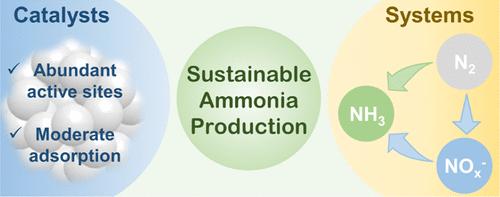当前位置:
X-MOL 学术
›
Acc. Mater. Res.
›
论文详情
Our official English website, www.x-mol.net, welcomes your
feedback! (Note: you will need to create a separate account there.)
Construction of Reaction System and Regulation of Catalyst Active Sites for Sustainable Ammonia Production
Accounts of Materials Research ( IF 14.0 ) Pub Date : 2024-10-28 , DOI: 10.1021/accountsmr.4c00103 Zhe Meng, Miao-Miao Shi, Jun-Min Yan
Accounts of Materials Research ( IF 14.0 ) Pub Date : 2024-10-28 , DOI: 10.1021/accountsmr.4c00103 Zhe Meng, Miao-Miao Shi, Jun-Min Yan

|
Ammonia (NH3) is widely used for human life and considered a green energy carrier without CO2 emissions; thus, green and sustainable NH3 synthesis is of great importance. The traditional Haber-Bosch process requires harsh conditions with serious environmental implications. Therefore, numerous research is focused on the efficient synthesis of NH3 from abundant N2/air and water under ambient conditions, utilizing renewable energy sources. Despite the fact that the electrocatalytic N2 reduction reaction (eNRR) is an ideal method for NH3 synthesis, the NH3 yield and Faradaic efficiency (FE) are severally hampered by the inertness of N2, impeding its industrial application. Various strategies have been proposed to synthesize highly efficient heterogeneous catalysts for N2 adsorption and dissociation to improve NH3 yield and FE. Besides, benefiting from the nonthermal plasma N2 oxidation reaction (pNOR) and electrocatalytic nitrate/nitrite reduction reaction (eNOxRR), the two-step approach overcomes the limitations of eNRR, attracting significant interest. This strategy facilitates N2 splitting, which is a crucial step in the synthesis of NH3. Additionally, eNOxRR involves complex intermediates, making it essential to investigate catalysts with high selectivity of NH3. Overall, through the optimization of catalysts and reaction systems, NH3 can be synthesized with high efficiency. The two-step strategy is the most realistic process for mass NH3 production, but several challenges still need to be addressed, including improving the overall energy efficiency and scaling up the technology for industrial applications.
中文翻译:

可持续氨生产的反应体系构建和催化剂活性位点的调节
氨 (NH3) 广泛用于人类生活,被认为是一种不排放 CO2 的绿色能源载体;因此,绿色和可持续的 NH3 合成非常重要。传统的 Haber-Bosch 工艺需要恶劣的条件,对环境有严重影响。因此,许多研究都集中在利用可再生能源在环境条件下从丰富的 N2/空气和水中高效合成 NH3。尽管电催化 N2 还原反应 (eNRR) 是合成 NH3 的理想方法,但 NH3 产率和法拉第效率 (FE) 受到 N2 惰性的严重影响,阻碍了其工业应用。已经提出了各种策略来合成用于 N2 吸附和解离的高效非均相催化剂,以提高 NH3 产率和 FE。此外,得益于非热等离子体 N2 氧化反应 (pNOR) 和电催化硝酸盐/亚硝酸盐还原反应 (eNOxRR),两步法克服了 eNRR 的局限性,引起了极大的兴趣。这种策略促进了 N2 的分裂,这是 NH3 合成的关键步骤。此外,eNOxRR 涉及复杂的中间体,因此必须研究对 NH3 具有高选择性的催化剂。总体而言,通过催化剂和反应体系的优化,可以高效合成 NH3。 两步策略是大规模 NH3 生产最现实的过程,但仍需要解决一些挑战,包括提高整体能源效率和扩大工业应用技术。
更新日期:2024-10-28
中文翻译:

可持续氨生产的反应体系构建和催化剂活性位点的调节
氨 (NH3) 广泛用于人类生活,被认为是一种不排放 CO2 的绿色能源载体;因此,绿色和可持续的 NH3 合成非常重要。传统的 Haber-Bosch 工艺需要恶劣的条件,对环境有严重影响。因此,许多研究都集中在利用可再生能源在环境条件下从丰富的 N2/空气和水中高效合成 NH3。尽管电催化 N2 还原反应 (eNRR) 是合成 NH3 的理想方法,但 NH3 产率和法拉第效率 (FE) 受到 N2 惰性的严重影响,阻碍了其工业应用。已经提出了各种策略来合成用于 N2 吸附和解离的高效非均相催化剂,以提高 NH3 产率和 FE。此外,得益于非热等离子体 N2 氧化反应 (pNOR) 和电催化硝酸盐/亚硝酸盐还原反应 (eNOxRR),两步法克服了 eNRR 的局限性,引起了极大的兴趣。这种策略促进了 N2 的分裂,这是 NH3 合成的关键步骤。此外,eNOxRR 涉及复杂的中间体,因此必须研究对 NH3 具有高选择性的催化剂。总体而言,通过催化剂和反应体系的优化,可以高效合成 NH3。 两步策略是大规模 NH3 生产最现实的过程,但仍需要解决一些挑战,包括提高整体能源效率和扩大工业应用技术。


















































 京公网安备 11010802027423号
京公网安备 11010802027423号